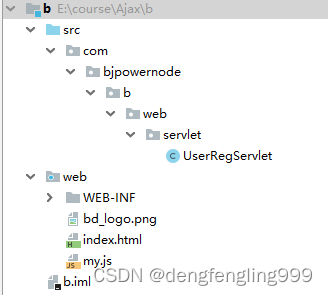目录:
(1)怎样理解跨域以及那些请求可以跨域
(2)在项目运行过程中可能出现的问题:不能正常显示图片:
(3)ajax跨域问题以及同源策略及解决方案
(1)怎样理解跨域以及那些请求可以跨域

跨域的理解:
 测试多种方式进行跨域请求
测试多种方式进行跨域请求
创建2个项目,并配置不同的服务器端口号不同:
a的Model去访问b的Model,模仿进行跨域请求
创建a Model:

index.html:超链接、form表单、js等都是可以跨域的,他们有一个共同特点,直接把浏览器的地址改变了
<!DOCTYPE html>
<html lang="en">
<head>
<meta charset="UTF-8">
<title>a应用的index页面</title>
</head>
<body>
<!--通过超链接的方式可以跨域吗?可以-->
<a href="http://localhost:8081/b/index.html">b的index页面(跨域访问)</a>
<!--form表单发送请求可以跨域吗?可以-->
<form action="http://localhost:8081/b/user/reg" method="post">
用户名:<input type="text" name="username"><br>
密码:<input type="password" name="password"><br>
<input type="submit" value="注册">
</form>
<br><br><br>
<!--通过js代码中的window.location.href/document.location.href可以跨域吗?可以-->
<button onclick="window.location.href='http://localhost:8081/b/index.html'">b的index页面(跨域访问)1</button>
<button onclick="document.location.href='http://localhost:8081/b/index.html'">b的index页面(跨域访问)2</button>
<!--使用script标签可以加载js文件,这个可以跨域吗?可以-->
<script type="text/javascript" src="http://localhost:8081/b/my.js"></script>
<br>
<!--加载其他站点的图片,可以跨域吗?可以-->
<img src="http://localhost:8081/b/bd_logo.png" />
</body>
</html>配置服务器tomcat:

创建b Model:

index.html:
<!DOCTYPE html>
<html lang="en">
<head>
<meta charset="UTF-8">
<title>b应用的index页面</title>
</head>
<body>
<h1>b应用的index页面</h1>
</body>
</html>my.js:
alert("b应用当中的my.js文件被加载并执行了。")UserRegServlet:
package com.bjpowernode.b.web.servlet;
import javax.servlet.ServletException;
import javax.servlet.annotation.WebServlet;
import javax.servlet.http.HttpServlet;
import javax.servlet.http.HttpServletRequest;
import javax.servlet.http.HttpServletResponse;
import java.io.IOException;
@WebServlet("/user/reg")
public class UserRegServlet extends HttpServlet {
@Override
protected void doPost(HttpServletRequest request, HttpServletResponse response)
throws ServletException, IOException {
// 获取用户名和密码
String username = request.getParameter("username");
String password = request.getParameter("password");
// 响应到前端
response.getWriter().print(username + ":" + password);
}
}
配置tomcat:

同时启动这两个项目:
当访问a Model中的index.html时:首先会使用script标签可以加载js文件触发alert


点击b的index页面(跨域访问):

在表单中输入数据:点击注册


点击b 的index跨域访问1:window.location.href

点击b 的index跨域访问2:document.location.href

(2)在项目运行过程中可能出现的问题:不能正常显示图片:

也不能直接访问图片:出现404资源在不到,可能是资源没有加载,重启服务器试试

可以去底层看一下有没有在里面:



如果发现没有这个图片 bd_logo.png

重新编译一下:选择Build Artifacts


然后再查看:

(3)ajax跨域问题以及同源策略及解决方案

/* * 默认情况下:发送ajax跨域请求的时候会出现以下错误: * Access to XMLHttpRequest at 'http://localhost:8081/b/hello' from origin 'http://localhost:8080' has been blocked by CORS policy: * No 'Access-Control-Allow-Origin' header is present on the requested resource. * 出现这个错误的根本原因是:跨域的时候,不允许共享同一个XMLHttpRequest对象。因为共享同一个XMLHttpRequest对象是不安全的。 * 重点提示:CORS策略阻止(这个ajax跨域请求被:同源策略阻止。) * 什么是同源策略????? * 同源策略是浏览器的一种安全策略。 * 什么是同源?什么是不同源? * 协议一致、域名一致、端口号一致。才是同源。 * 只要上面的任一元素不一致,就是不同源。 * 同源:XMLHttpRequest对象可以共享。 * 不同源:XMLHttpRequest对象不可以共享。 */
浏览器没变,浏览器内存只有一份,然后你再同一份内存中你去访问b站点的资源相当于跨域了,两个站点要共享XMLHttpReques对象这个是不允许的。
从一个站点发送ajax请求另一个站点的资源,就意味着另外一个站点和这个站点共享XMLHttpRequest对象,就存在了安全问题,默认情况下是不允许的,所以ajax是不允许跨域的
现在的系统是分布时系统:是需要跨域访问的

ajax1.html:
<!DOCTYPE html>
<html lang="en">
<head>
<meta charset="UTF-8">
<title>测试:ajax跨域访问会不会有问题???</title>
</head>
<body>
<script type="text/javascript">
/*window.onload = function(){
document.getElementById("btn").onclick = function(){
}
}*/
/*
* 默认情况下:发送ajax跨域请求的时候会出现以下错误:
* Access to XMLHttpRequest at 'http://localhost:8081/b/hello' from origin 'http://localhost:8080' has been blocked by CORS policy:
* No 'Access-Control-Allow-Origin' header is present on the requested resource.
* 出现这个错误的根本原因是:跨域的时候,不允许共享同一个XMLHttpRequest对象。因为共享同一个XMLHttpRequest对象是不安全的。
* 重点提示:CORS策略阻止(这个ajax跨域请求被:同源策略阻止。)
* 什么是同源策略?????
* 同源策略是浏览器的一种安全策略。
* 什么是同源?什么是不同源?
* 协议一致、域名一致、端口号一致。才是同源。
* 只要上面的任一元素不一致,就是不同源。
* 同源:XMLHttpRequest对象可以共享。
* 不同源:XMLHttpRequest对象不可以共享。
*/
// 使用ES6新特性:箭头函数
window.onload = () => {
document.getElementById("btn").onclick = () => {
// 发送ajax的跨域请求
// 1. 创建核心对象
// let是一个关键字,可以定义变量。
// ES6的新特性:let和const关键字都可以定义变量。
// 注意:在JS中声明变量,可以使用:var let const。他们之间有什么区别?自己研究。
let xmlHttpRequest = new XMLHttpRequest();
// 2. 注册回调函数
xmlHttpRequest.onreadystatechange = () => {
if (xmlHttpRequest.readyState == 4) {
if (xmlHttpRequest.status >= 200 && xmlHttpRequest.status < 300) {
document.getElementById("mydiv").innerHTML = xmlHttpRequest.responseText
}
}
}
// 3. 开启通道
xmlHttpRequest.open("GET", "http://localhost:8081/b/hello", true)
// 4. 发送请求
xmlHttpRequest.send()
}
}
</script>
<button id="btn">发送ajax跨域请求</button>
<div id="mydiv"></div>
</body>
</html>跨域的解决方案:


HelloServlet:设置跨域访问,设置响应头,允许ajax跨域访问
package com.bjpowernode.b.web.servlet;
import javax.servlet.ServletException;
import javax.servlet.annotation.WebServlet;
import javax.servlet.http.HttpServlet;
import javax.servlet.http.HttpServletRequest;
import javax.servlet.http.HttpServletResponse;
import java.io.IOException;
@WebServlet("/hello")
public class HelloServlet extends HttpServlet {
@Override
protected void doGet(HttpServletRequest request, HttpServletResponse response)
throws ServletException, IOException {
// 设置响应头,允许ajax跨域请求
//response.setHeader("Access-Control-Allow-Origin", "http://localhost:8080");
response.setHeader("Access-Control-Allow-Origin", "*");
// 响应
//response.getWriter().print("hello ajax!!!");
response.getWriter().print("{\"username\":\"zhangsan\"}");
}
}
如果不设置会报错:


点击发送ajaax跨域请求:
